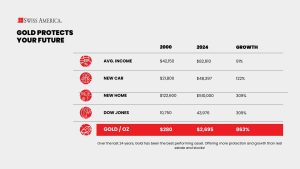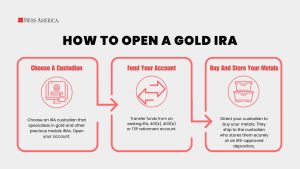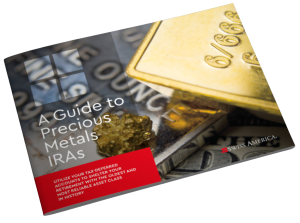
Have you thought about how to protect your retirement savings from inflation and market swings? Are you looking for a way to strengthen your portfolio? A Physical Gold IRA could be the answer.
It lets you hold physical gold while enjoying the same tax benefits as other retirement accounts. Gold has been a reliable asset through economic uncertainty, inflation, and market ups and downs, making it a smart choice if you want to secure your financial future.
This article will explain what Gold IRA is and guide you on how to get started.
Introduction to a Gold IRA
A Gold IRA is a retirement account where you can include real gold and other precious metals in your savings. It gives you a way to diversify your portfolio beyond just stocks and bonds that you hold in a traditional IRA.
Why would you want to do this? The main reason is that gold can hold its value during inflation and market volatility, which can help reduce the risks that you have with paper assets.
You might also hear these accounts referred to as precious metals IRAs or gold and silver IRAs.
Benefits of investing in a physical Gold IRA
A Gold IRA can help strengthen your retirement accounts by:
1. Hedge against inflation
Gold protects against inflation because it operates outside the monetary system. Paper currency can lose purchasing power when the government prints more. Gold’s value comes from its scarcity and universal demand.
During inflationary periods, the cost of goods rises, and gold prices rise as well because it takes more currency to purchase the same amount of gold. This reflects gold’s role as a finite asset that holds purchasing power over time.
The chart below compares the increase in gold prices compared to other goods and services:

2. Portfolio diversification
Adding gold to your portfolio improves diversification because it moves independently of stocks and bonds. Equities rely on corporate profits, and bonds react to interest rates, but gold responds to currency shifts and crises.
During market downturns or economic uncertainty, investors seek stability and turn to gold. This helps offset losses you might have in other assets and reduces your overall portfolio risk.
3. Tangible asset
Owning physical gold gives you a real asset that doesn’t rely on markets, companies, or governments. It carries no counterparty risk, which means its value doesn’t depend on someone else’s ability to deliver.
When banks freeze accounts, markets crash, or currencies lose value, gold remains accessible and retains its purchasing power.
How to set up a Gold IRA
Here are the steps to set up a Gold IRA and start investing in gold for your retirement:
1. Choosing an IRA company
Start by picking a precious metals IRA custodian to manage your account. Similar to administrators for traditional IRAs, their role is to handle the retirement funds that you invest in precious metals.
Look for a company with good customer reviews, transparent pricing, and helpful support. You’ll have administrative, storage, and other fees, so it pays to compare options.
Open a self-directed IRA account with the custodian you choose.
2. IRA rollover process
Next, you’ll fund your account. If you’ve left your employer, you can roll over your 401(k), 403(b), or TSP account into a Gold IRA. The best route is to use a direct rollover where your current administrator sends the funds to your Gold IRA custodian.
You can also convert an existing IRA to gold, or you can set up a brand new account.
3. Buy and store your gold and other precious metals
Work with precious metals dealers like Swiss America to decide which gold bullion coins or bars to buy. You can’t just buy any metal because the IRS has specific rules around which metals qualify for precious metal IRAs. Your gold dealer can help guide you on the options.
From there, you’ll direct your Gold IRA custodian to buy the metals on your behalf. They’ll also facilitate secure storage of your metals in a depository until you reach the retirement age of 59.5.

Types of physical gold for IRA
IRS rules for approved gold include:
Gold coins
Investors like gold coins because they are easy to buy, sell, and store. IRS requires coins to meet 99.5% purity and come from approved government mints or manufacturers. You can buy coins in different sizes ranging from 1/10 ounce to 1 ounce.
Common IRA-approved coins include:
-
Canadian Gold Maple Leaf
-
Austrian Gold Philharmonic
-
British Gold Britannia
Gold bars
Gold bars also need to meet the 99.5% purity requirement and come from an approved refinery or mint. Some accepted gold bars include:
-
PAMP Suisse Gold Bars
-
Valcambi Gold Bars
-
Royal Canadian Mint Gold Bars
-
Credit Suisse Gold Bars
Gold bars have lower premiums than coins, so you can buy larger amounts of gold for a lower cost per ounce. Eligible gold bars come in different sizes, from 1 oz to 1 kilogram or about 32.15 oz.
Costs and fees associated with physical Gold IRA
Just like other investments, you’ll have fees to support your precious metal IRA, including:
Storage fees
The IRS requires your custodian to store your metals in an IRS-approved depository. This is because if you actually take physical possession, the IRS considers this a distribution of your retirement funds.
Storage fees range from $50 to more per year, depending on your custodian and if they charge a flat fee or percentage of asset fee. The cost can vary depending on the depository, insurance coverage, and storage type.
Depositories offer two storage options:
Commingled storage: The depository keeps your gold in the same area as other investors’ gold. This shared storage option costs less.
Segregated storage: With this option, the depository keeps your gold separate from other investors’ metals. As you can guess, this approach costs more, but some investors like this better than commingled storage.
Other account fees
Besides storage, other account fees can include:
Account setup fees: Custodians charge a fee to set up your Gold IRA, ranging from $50 to $100 or more.
Annual maintenance fees: You’ll also pay yearly fees for account maintenance. These can range from $75 to more, depending on the custodian and the complexity of your account.
Markups on gold purchases: Your precious metals dealer also has a markup above the market price to cover the cost of processing and shipping your gold.
Tax implications
A Gold IRA has tax benefits and rules just like traditional IRAs:
Account types
You can have either a traditional Gold IRA or a Roth Gold IRA. The difference is in how you fund them:
Traditional Gold IRAs: You add money to these accounts with pre-tax dollars. This allows your investment to grow tax-deferred, and you’ll only pay taxes when you withdraw funds in retirement. The benefit here is that when you do pay taxes, you might be in a lower tax bracket.
Roth Gold IRAs: Roth IRAs let you invest after-tax dollars into your account. Your investments grow tax-free, and you can withdraw funds in retirement without any additional taxes as long as you’ve held the account for five years.
Early withdrawals
Just like a traditional IRA, if you withdraw your investments before reaching retirement age, you’ll be subject to IRS penalties and income taxes.
Taxation of distributions
Tax treatment of your withdrawals depends on your IRA account type:
Traditional Gold IRA: You’ll pay taxes on the value of your gold as ordinary income. You also can’t just leave the money in your IRA forever, so the IRS requires minimum distributions once you reach age 73.
Roth Gold IRA: You can take out your contributions at any time without additional taxes. Then, when you reach retirement age, you can withdraw your proceeds tax-free as long as you meet the five-year requirement. With this account type, you don’t have required minimum distributions.
Risks and considerations
Before you make any investment, it’s always a good idea to consider the potential risks:
Market volatility
Gold is considered stable, but its price can still vary due to changes in global markets, economic shifts, or investor behavior.
To handle these ups and downs, it’s best to think of gold as a long-term investment.
No income
Gold and physical precious metals do not generate income. Most investors are OK with this because they hold precious metals as an “insurance policy” to protect their retirement accounts. The whole point of these assets is protection and risk reduction, not income generation.
Why Swiss America
You’ll want to pick the right precious metals dealer to help you with Gold IRA investing. Here’s some of the reasons other investors work with Swiss America:
-
Reliability: We’ve been in business since the 1980s and we’ve built a strong reputation as a dependable partner through changing markets.
-
Customer satisfaction: We deliver high-quality metals along with excellent customer service. Thousands of happy clients trust us for ongoing support.
-
Expert advice: Our team offers guidance on IRA rollovers, diversifying your portfolio, and understanding the gold-to-silver ratio, helping you make the best decisions for your retirement account.
Gold in IRA final thoughts
A Gold IRA offers stability and diversification, helping protect your retirement savings from inflation, economic changes, and market ups and downs. Holding real gold gives you the safety of a physical asset and tax benefits like other retirement accounts.
A Gold IRA might be the right choice if you want to secure your financial future with a stable, real asset. To learn more about how to hold gold in your IRA, check out our free Gold IRA kit today!
Physical Gold IRA: FAQs
How much does it cost to have a gold IRA?
The cost of a Gold IRA can vary but includes setup fees, annual maintenance fees, and storage fees for the gold. These fees usually range from $100 to $300 annually, depending on the custodian and storage options.
What is the average return on a gold IRA?
The average return on a gold IRA varies depending on market conditions, but historically, gold has provided an average annual return of around 6-7%. However, returns can fluctuate based on economic factors and gold prices.
Is a gold IRA tax free?
A gold IRA is not tax-free, but it offers tax advantages. Depending on the type of account, contributions may be tax-deductible if it’s a traditional gold IRA, or withdrawals can be tax-free in the case of a Roth Gold IRA.
Note: The information in this post is for informational purposes only and should not be considered tax or legal advice. Please consult with your own tax professionals before making any decisions or taking action based on this information.
